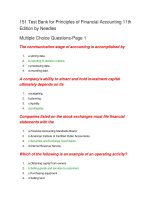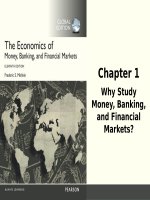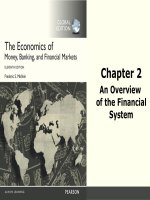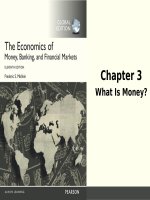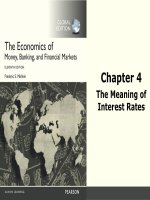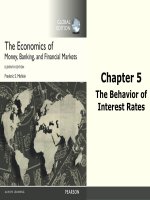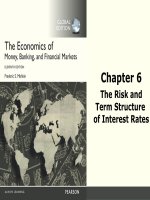The economics of money, banking, and financial institutions (11th edition) by f s mishkin ch6 the risk and term structure of interest rates
Bạn đang xem bản rút gọn của tài liệu. Xem và tải ngay bản đầy đủ của tài liệu tại đây (834.13 KB, 31 trang )
Chapter 6
The Risk and
Term Structure
of Interest Rates
20-1
© 2016 Pearson Education Ltd. All rights reserved.
Preview
• In this chapter, we examine the sources and
causes of fluctuations in interest rates
relative to one another, and look at a
number of theories that explain these
fluctuations.
1-2
© 2016 Pearson Education Ltd. All rights reserved.
Learning Objectives
• Identify and explain three factors explaining
the risk structure of interest rates.
• List and explain the three theories of why
interest rates vary across maturities.
1-3
© 2016 Pearson Education Ltd. All rights reserved.
Risk Structure of Interest Rates
• Bonds with the same maturity have
different interest rates due to:
– Default risk
– Liquidity
– Tax considerations
1-4
© 2016 Pearson Education Ltd. All rights reserved.
Figure 1 Long-Term Bond Yields,
1919–2014
Sources: Board of Governors of the Federal Reserve System, Banking and Monetary Statistics,
1941–1970; Federal Reserve Bank of St. Louis FRED database: />1-5
© 2016 Pearson Education Ltd. All rights reserved.
Risk Structure of Interest Rates
• Default risk: probability that the issuer of
the bond is unable or unwilling to make
interest payments or pay off the face value
– U.S. Treasury bonds are considered default free
(government can raise taxes).
– Risk premium: the spread between the interest
rates on bonds with default risk and the interest
rates on (same maturity) Treasury bonds
1-6
© 2016 Pearson Education Ltd. All rights reserved.
Figure 2 Response to an Increase in
Default Risk on Corporate Bonds
Price of Bonds, P
Price of Bonds, P
ST
Sc
T
i2
Risk
Premium
P c1
T
P2
T
P1
c
P2
c
i2
c
D2
D2T
D1T
c
D1
Quantity of Corporate Bonds
(a) Corporate bond market
Quantity of Treasury Bonds
(b) Default-free (U.S. Treasury) bond market
Step 1. An increase in default risk shifts the demand
curve for corporate bonds left . . .
Step 2. and shifts the demand curve for Treasury bonds
to the right . . .
Step 3. which raises the price of Treasury bonds and lowers the
price of corporate bonds, and therefore lowers the interest rate
on Treasury bonds and raises the rate on corporate bonds,
thereby increasing the spread between the interest rates on
corporate versus Treasury bonds.
1-7
© 2016 Pearson Education Ltd. All rights reserved.
Table 1 Bond
Ratings by
Moody’s,
Standard and
Poor’s, and
Fitch
1-8
© 2016 Pearson Education Ltd. All rights reserved.
Risk Structure of Interest Rates
• Liquidity: the relative ease with which an
asset can be converted into cash
– Cost of selling a bond
– Number of buyers/sellers in a bond market
• Income tax considerations
– Interest payments on municipal bonds are
exempt from federal income taxes.
1-9
© 2016 Pearson Education Ltd. All rights reserved.
Figure 3 Interest Rates on Municipal
and Treasury Bonds
Price of Bonds, P
Price of Bonds, P
ST
Sm
P m2
P1T
P m1
D m1
D m2
P 2T
D2T
Quantity of Municipal Bonds
(a) Market for municipal bonds
D1T
Quantity of Treasury Bonds
(b) Market for Treasury bonds
Step 1. Tax-free status shifts the demand for municipal
bonds to the right . . .
Step 2. and shifts the demand for Treasury bonds to the
left . . .
Step 3. with the result that municipal bonds end up with a
higher price and a lower interest rate than on Treasury bonds.
1-10
© 2016 Pearson Education Ltd. All rights reserved.
Effects of the Obama Tax Increase
on Bond Interest Rates
• In 2013, Congress approved legislation
favored by the Obama administration to
increase the income tax rate on high-income
taxpayers from 35% to 39%. Consistent with
supply and demand analysis, the increase in
income tax rates for wealthy people helped
to lower the interest rates on municipal
bonds relative to the interest rate on
Treasury bonds.
1-11
© 2016 Pearson Education Ltd. All rights reserved.
Term Structure of Interest Rates
• Bonds with identical risk, liquidity, and tax
characteristics may have different interest
rates because the time remaining to
maturity is different
1-12
© 2016 Pearson Education Ltd. All rights reserved.
Term Structure of Interest Rates
• Yield curve: a plot of the yield on bonds
with differing terms to maturity but the
same risk, liquidity and tax considerations
– Upward-sloping: long-term rates are above
short-term rates
– Flat: short- and long-term rates are the same
– Inverted: long-term rates are below short-term
rates
1-13
© 2016 Pearson Education Ltd. All rights reserved.
Term Structure of Interest Rates
The theory of the term structure of interest
rates must explain the following facts:
1-14
1.
Interest rates on bonds of different maturities
move together over time.
2.
When short-term interest rates are low, yield
curves are more likely to have an upward
slope; when short-term rates are high, yield
curves are more likely to slope downward and
be inverted.
3.
Yield curves almost always slope upward.
© 2016 Pearson Education Ltd. All rights reserved.
Term Structure of Interest Rates
Three theories to explain the three facts:
1. Expectations theory explains the first
two facts but not the third.
2. Segmented markets theory explains the
third fact but not the first two.
3. Liquidity premium theory combines the
two theories to explain all three facts.
1-15
© 2016 Pearson Education Ltd. All rights reserved.
Figure 4 Movements over Time of
Interest Rates on U.S. Government Bonds
with Different Maturities
Sources: Federal Reserve Bank of St. Louis FRED database:
/>1-16
© 2016 Pearson Education Ltd. All rights reserved.
Expectations Theory
• The interest rate on a long-term bond will equal an
average of the short-term interest rates that people
expect to occur over the life of the long-term bond.
• Buyers of bonds do not prefer bonds of one
maturity over another; they will not hold
any quantity of a bond if its expected return
is less than that of another bond with a different
maturity.
• Bond holders consider bonds with different
maturities to be perfect substitutes.
1-17
© 2016 Pearson Education Ltd. All rights reserved.
Expectations Theory
An example:
• Let the current rate on one-year bond be 6%.
• You expect the interest rate on a one-year
bond to be 8% next year.
• Then the expected return for buying two
one-year bonds averages (6% + 8%)/2 =
7%.
• The interest rate on a two-year bond must
be 7% for you to be willing to purchase it.
1-18
© 2016 Pearson Education Ltd. All rights reserved.
Expectations Theory
For an investment of $1
it = today's interest rate on a one-period bond
ite+1 = interest rate on a one-period bond expected for next period
i2t = today's interest rate on the two-period bond
1-19
© 2016 Pearson Education Ltd. All rights reserved.
Expectations Theory
Expected return over the two periods from investing $1 in the
two-period bond and holding it for the two periods
(1 + i2t )(1 + i2t ) − 1
= 1 + 2i2t + (i2t ) 2 − 1
= 2i2t + (i2t ) 2
Since (i2t ) 2 is very small
the expected return for holding the two-period bond for two periods is
2i2t
1-20
© 2016 Pearson Education Ltd. All rights reserved.
Expectations Theory
If two one-period bonds are bought with the $1 investment
(1 + it )(1 + ite+1 ) − 1
1 + it + ite+1 + it (ite+1 ) − 1
it + ite+1 + it (ite+1 )
it (ite+1 ) is extremely small
Simplifying we get
it + ite+1
1-21
© 2016 Pearson Education Ltd. All rights reserved.
Expectations Theory
Both bonds will be held only if the expected returns are equal
2i2t = it + ite+1
it + ite+1
i2t =
2
The two-period rate must equal the average of the two one-period rates
For bonds with longer maturities
int =
it + ite+1 + ite+ 2 + ... + ite+ ( n −1)
n
The n-period interest rate equals the average of the one-period
interest rates expected to occur over the n-period life of the bond
1-22
© 2016 Pearson Education Ltd. All rights reserved.
Expectations Theory
• Expectations theory explains:
– Why the term structure of interest rates changes
at different times.
– Why interest rates on bonds with different
maturities move together over time (fact 1).
– Why yield curves tend to slope up when shortterm rates are low and slope down when shortterm rates are high (fact 2).
• Cannot explain why yield curves usually slope
upward (fact 3)
1-23
© 2016 Pearson Education Ltd. All rights reserved.
Segmented Markets Theory
• Bonds of different maturities are not substitutes at
all.
• The interest rate for each bond with a different
maturity is determined by the demand for and
supply of that bond.
• Investors have preferences for bonds of one
maturity over another.
• If investors generally prefer bonds with shorter
maturities that have less interest-rate risk, then
this explains why yield curves usually slope upward
(fact 3).
1-24
© 2016 Pearson Education Ltd. All rights reserved.
Liquidity Premium &
Preferred Habitat Theories
• The interest rate on a long-term bond will
equal an average of short-term interest
rates expected to occur over the life of the
long-term bond plus a liquidity premium
that responds to supply and demand
conditions for that bond.
• Bonds of different maturities are partial (not
perfect) substitutes.
1-25
© 2016 Pearson Education Ltd. All rights reserved.
